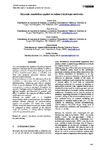Dynamic Simulation Applied to Refinery Hydrogen Networks

Ver/Abrir
Use este enlace para citar
http://hdl.handle.net/2183/25815
Excepto si se señala otra cosa, la licencia del ítem se describe como Atribución-NoComercial-CompartirIgual 4.0 España
Colecciones
Metadatos
Mostrar el registro completo del ítemTítulo
Dynamic Simulation Applied to Refinery Hydrogen NetworksAutor(es)
Fecha
2017Cita bibliográfica
Galán Prado, A., Prada Moraga, C., Gutiérrez Rodríguez, G., González Martín ,R., Sarabia Ortiz, D. Dynamic Simulation Applied to Refinery Hydrogen Networks. En Actas de las XXXVIII Jornadas de Automática, Gijón, 6-8 de Septiembre de 2017 (pp.555-562). DOI capítulo: https://doi.org/10.17979/spudc.9788497497749.0555 DOI libro: : https://doi.org/10.17979/spudc.9788497497749
Versiones
http://hdl.handle.net/10651/46830
Resumen
[Abstract] This study analyses the usefulness of process network dynamics simulation for decision-making in refinery hydrogen networks. A theoretical hydrogen network of three desulphurisation plants is modelled, and three case scenarios discussed: baseline, high demand, and low demand. Discussion focuses on how the information from the simulation is interpreted and its usefulness for debottlenecking, scheduling and what-if analysis. Stress is put on dynamics of the system and their consequences in process operation throughout the network. Hydrogen purity is highlighted as the most affected variable, and discussed its network wide effect. In addition, the responses of inflows, outflows and headers are analysed. Although the model used is a simplified representation of the actual processes, the simulation analysis showed potential as decision-making support not provided with steady state models. Further researches based on real case-studies should be conducted to better conclude on the efficient usage of simulation in aiding refinery hydrogen networks operational decisions
Palabras clave
Network simulation
Process dynamics
Decision-making
Process dynamics
Decision-making
Versión del editor
Derechos
Atribución-NoComercial-CompartirIgual 4.0 España
ISBN
978-84-16664-74-0 (UOV) 978-84-9749-774-9 (UDC electrónico)






